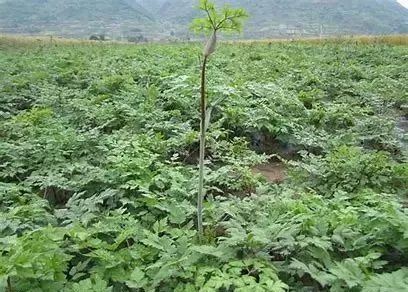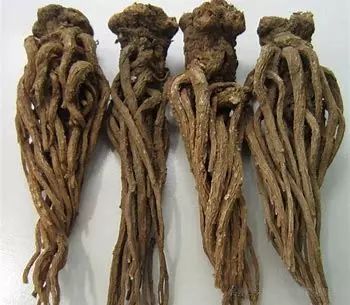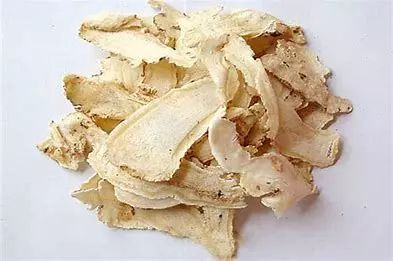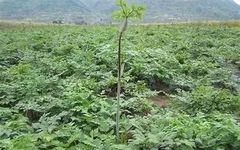


“Chinese Herbal Medicine Encyclopedia”: Angelica Sinensis
Pinyin Dānɡ Guī
Alias Gan Gui (“Shennong’s Classic”)
Source “Shennong’s Classic”
Origin The root of the plant Angelica sinensis (Oliv.) Diels, belonging to the Apiaceae family. It generally requires three years of cultivation before harvesting. The roots are dug up in late autumn, cleaned of stems and soil, and dried in a ventilated area for several days. They are then bundled according to size and lightly smoked to ensure thorough drying. This product is oily and prone to mold and insect damage, so it must be stored in a dry place. During moldy and rainy seasons, it should be treated with sulfur or appropriately dried.
Plant Morphology Angelica sinensis, also known as: Bi, Shan Qi, Bai Qi (“Erya”), Wen Wu (Cui Bao “Ancient and Modern Annotations”).
It is a perennial herb, growing 0.4 to 1 meter tall. The stem is erect, purplish, with distinct longitudinal grooves, smooth and hairless. The leaves are 2-3 times pinnately divided, with petioles 3-11 cm long, and the basal leaf sheath is swollen; leaflets are ovate; there are 3 pairs of small leaflets, with the pair closest to the petiole having petioles 0.5-1.5 cm long, while the pair near the apex is sessile, with 1-2 times divided lobes, and the edges of the lobes are serrated. The compound umbel inflorescence is terminal, with 10-14 unequal rays, and 2 linear bracts at the base, or absent; there are 2-4 small bracts, linear; the small umbel has 12-36 flowers, with pedicels 0.3-1.5 cm long, densely covered with fine hairs; the calyx has 5 lobes, which are finely ovate; the petals are 5, white, elongated ovate, with a narrow tip, slightly folded inward, hairless; there are 5 stamens, with filaments bent inward; the ovary is inferior, with a short style and a conical base. The double-samaras are oval, 4-6 mm long and 3-4 mm wide, easily separating at maturity; the mericarps have 5 ridges, with the dorsal ridge linearly raised, and the lateral ridges developing into wide, thin wings, with the wing edges pale purple; the transverse section is flat on the back, with one oil duct in each groove, and two oil ducts on the fused surface. The flowering period is from June to July, and the fruiting period is from July to August.
Habitat Distribution Distributed in Gansu, Sichuan, Yunnan, Shaanxi, Guizhou, Hubei, and other regions. Cultivated in various places, mainly produced in Gansu and Yunnan. Additionally, Shaanxi, Sichuan, Hubei, and Guizhou also produce it.
Characteristics The dried root can be divided into three parts: the root head is called “Gui Tou”, the main root is called “Gui Shen”, and the lateral roots and their tips are called “Gui Wei”. The total length is about 10-25 cm, with the body length about 3-10 cm. The diameter of the root head is 2-4 cm, and the lateral roots are 0.3-1 cm in diameter. The exterior is gray-brown or brown, with longitudinal wrinkles throughout, especially abundant at the lateral root part. The top of the root head is rounded and flat, with remnants of stem and leaves, often with indistinct ring-like wrinkles. The body is slightly cylindrical, with an uneven surface, and has 3-5 or more lateral roots below, which are thick at the top and thin at the bottom, often twisted, with small nodular root hair marks on the surface. The texture is mostly flexible, with a yellow-white cross-section, having fissures, and the middle layer has light brown ring patterns with numerous brown oil spots. The aroma is clear and strong, with a sweet, slightly bitter, and spicy taste.
Quality is best when the main root is large, the body is long, there are few lateral roots, the cross-section is yellow-white, and the aroma is strong. Inferior quality is characterized by a small main root, many lateral roots, a weaker aroma, and a reddish-brown cross-section.
Chemical Composition The root contains volatile oil, with the Gansu Minxian variety containing 0.4%, and the Sichuan Wenchuan variety containing 0.7%. The main components of the volatile oil include: butylidenephthalide, o-carboxyphenylpentanone, and Δ2,4-dihydrophthalic anhydride.
The volatile oil components are complex, with more than 10 types in the low boiling point portion, including various hydrocarbons, including 3 types of terpenes. It also contains a large amount of sucrose (40%), vitamin B12 (0.25-40 micrograms/100 grams), and vitamin A-like substances (with a content of 0.0675% when calculated as vitamin A). The saponifiable portion of the root contains palmitic acid, stearic acid, myristic acid, and unsaturated oleic acid, while the unsaponifiable components include β-sitosterol.
The whole herb has a fragrance, indicating that all parts contain volatile oil, with the fruit containing a particularly high amount.
The roots of Dong Quai and Beihai Dong Quai contain about 0.2% volatile oil, with phthalide components including ligustilide, butylidenephthalide, cnidilide, and isocnidilide. Additionally, they contain sesquiterpenes, p-cymene, sucrose, vitamin B12, niacin, folic acid, and β-sitosterol. The former also contains butylphthalide and sedanolide. The volatile oils of both types of Dong Quai roots and fruits also contain butanol and acetic acid.
Processing Angelica Sinensis: Remove impurities, wash clean, moisten, and slightly dry until the internal and external humidity is suitable, then slice and dry in the sun. Wine Angelica: Take Angelica slices, spray evenly with yellow wine, slightly moisten, and stir-fry in a pot over low heat, then cool (100 pounds of Angelica slices use 10 pounds of yellow wine).
According to “The Classic of Processing and Fire”: “When using Angelica, first remove dust and the hard parts from the head, soak in wine overnight.”
Taste and Properties Sweet, spicy, warm.
① “Shennong’s Classic”: “Taste is sweet, warm.”
② “Wu Pu Materia Medica”: “Shennong, Huangdi, Tongjun, Bian Que: sweet, non-toxic. Qibo, Lei Gong: spicy, non-toxic. Li’s: slightly warm.”
③ “Bielu”: “Spicy, very warm, non-toxic.”
④ “Materia Medica Commentary”: “Taste is bitter, warm, non-toxic.”
Meridian Affinity Enters the Heart, Liver, and Spleen meridians.
① “Soup Liquid Materia Medica”: “Enters the Hand Shaoyin, Foot Taiyin, and Jueyin meridians.”
② “Lei Gong’s Processing and Medicinal Properties Explanation”: “Enters the Heart, Liver, and Lung meridians.”
Functions and Indications Nourishes blood and regulates menstruation, alleviates pain, moistens dryness, and lubricates the intestines. Treats irregular menstruation, amenorrhea, abdominal pain, masses, excessive bleeding; blood deficiency headaches, dizziness, atrophy; dry intestines and constipation, post-dysentery heaviness; carbuncles and sores, trauma.
① “Shennong’s Classic”: “Mainly treats cough, counterflow qi, warms malaria, cold and heat washing in the skin, women’s leakage, infertility, various sores and wounds, decocted for drinking.”
② “Bielu”: “Warms the middle, alleviates pain, removes blood stasis, treats wind stroke, sweating, damp bi, and evil qi, nourishes the five organs, and promotes muscle growth.”
③ “Medicinal Properties Theory”: “Stops vomiting, counterflow, deficiency cold and heat, breaks stagnant blood, treats women’s excessive bleeding, cold in the intestines and stomach, nourishes deficiencies, stops dysentery and abdominal pain. Decoction for drinking treats warm malaria, mainly for women with bleeding waist pain, and alleviates unbearable tooth pain. For patients with deficiency cold, use it more.”
④ “Rihua’s Materia Medica”: “Treats all wind, all blood, nourishes all deficiencies, breaks evil blood, nourishes new blood, and treats masses.”
⑤ “Pearl Bag”: “Head breaks blood. Body harmonizes blood, tail stops blood. (“Soup Liquid Materia Medica” quotes as ‘head stops blood, body harmonizes blood, tail breaks blood’)”
⑥ Li Gao: “Angelica tail mainly treats masses, breaks evil blood, and postpartum evil blood surging, removes various sores and swellings, treats golden wounds and evil blood, warms the middle, moistens dryness, and alleviates pain.”
⑦ Wang Haogu: “Mainly treats atrophy, excessive desire to lie down, heat and pain in the feet. For diseases of the Chong vessel, counterflow qi and urgency; for diseases of the Dai vessel, abdominal pain, and a feeling of sitting in water.”
⑧ “Materia Medica Mengquan”: “Expels blood clots from trauma, and treats painful obstruction from heat dysentery.”
⑨ “Governing Principles”: “Treats headaches, abdominal pain, moistens intestines, muscles, bones, and skin. Treats carbuncles, drains pus, alleviates pain, harmonizes blood, and nourishes blood.”
⑩ “Materia Medica Revisited”: “Treats whole body swelling, blood vessels not harmonizing, insufficient yin, stabilizes pregnancy, and prevents miscarriage.”
Dosage and Administration Internal use: decoction, 6-12 grams; or in pills, powders; or soaked in wine; or as a plaster.
Precautions Use cautiously in cases of damp obstruction and diarrhea.
① “Materia Medica Classic Annotations”: “Avoid with ginger, seaweed, and mulberry.”
② “Medicinal Pairing”: “Avoid dampness, and be cautious with fresh ginger.”
③ “Materia Medica Commentary”: “Weak intestines and stomach, diarrhea, and all spleen and stomach diseases, avoid use, especially during pregnancy and before childbirth.”
④ “Materia Medica Compilation”: “If wind and cold are not cleared, avoid use in cases of cold and fever with external symptoms.”
Various Discussions 1. “Annotations on Cold Damage Theory”: “The pulse is the residence of blood, all blood belongs to the heart, and all channels must first nourish the heart and blood. Therefore, Zhang Zhongjing treats cold in the hands and feet, with a thin pulse wanting to disappear, using the bitter warmth of Angelica to assist heart blood.”
2. “Secret of Treatment”: “Angelica has three uses: it is the main medicine for the heart, harmonizes blood, and treats all diseases that worsen at night. It treats both internal and external, and must be soaked in wine to dissolve hardness. For unbearable eye pain, use Huanglian and Angelica root soaked in wine.”
3. Li Gao: “Angelica head stops blood and ascends; body nourishes blood and guards; tail breaks blood and descends; the whole herb activates blood without moving it. Users should not separate them, as it is better not to use it at all. If used whole, it can nourish blood like ginseng and astragalus; if used with Qian Niu Zi and Da Huang, it can break blood, and users should know how to use it properly.”
4. “Soup Liquid Materia Medica”: “Angelica enters the hand Shaoyin, as the heart governs blood; enters the foot Taiyin, as the spleen stores blood; enters the foot Jueyin, as the liver stores blood. The head can break blood, the body can nourish blood, and the tail can move blood. Users should not separate them, as it is better not to use it at all. If used whole, it can nourish blood like ginseng and astragalus; if used with Qian Niu Zi and Da Huang, it can break blood, and users should know how to use it properly.”
5. “Han’s Medical Communication”: “Angelica mainly treats blood-related diseases, and the strength of the Sichuan variety is suitable for attacking, while the Gansu variety is softer and suitable for nourishing. When using this medicine, it should be prepared with wine, while phlegm should be soaked in ginger juice to guide blood back to its source.”
6. “Materia Medica Compilation”: “Angelica treats headaches, boiled in wine, to take its clear floating and rising properties. It treats heart pain, adjusted with wine, to take its turbid and half-sinking properties. It treats blood in urine, using wine to decoct, to take its sinking properties. There are clear distinctions in this regard.”
7. “Materia Medica Compilation”: “All diseases that worsen at night are blood diseases, and it should be used. All diseases that are deficient and cold, with no yang to attach to, should also use it. Warm malaria and cold heat do not occur in the skin or muscles, but wash in the skin. Observing the skin, the meeting of the nutrient qi, warm malaria lingers, and the nutrient qi is deficient, causing cold and heat to contend, sweating occurs. Using blood medicine nourishes the nutrient qi, harmonizing it with the protective qi, and when the nutrient and protective qi are harmonized, how can warm malaria not be stopped?”
8. “Materia Medica Justice”: “Angelica, with its sweet and heavy taste, is specialized in nourishing blood. Its light and spicy aroma allows it to activate blood. It is indeed the qi medicine of blood, and also the holy medicine of blood. Generally, when used with nourishing agents, it can nourish the nutrient qi and blood, supplement qi and generate essence, calm the five organs, strengthen the body, and benefit the spirit. It is suitable for all diseases of physical deficiency. When used with attacking agents, it can also relieve pain, promote bowel movements, and benefit the muscles and bones, treating spasms, paralysis, dryness, and other symptoms. When the nutrient qi is deficient and the exterior is unresolved, it should be combined with Chai Hu, Ge Gen, Ma Huang, and Gui Zhi to disperse exterior heat. When combined with Da Huang and Mang Xiao, it can also be cold. Only when wine is steamed with Angelica can it treat headaches, as all headaches belong to wood, and thus blood medicine governs them.”
9. “Materia Medica Justice”: “The body of Angelica guards and supplements effectively, while the tail promotes and expels. The head has an upward action, suitable for stopping blood in urine and bleeding. If blood rises and floats due to qi fire, it is suitable to assist with warming and rising. It is indeed the two words of stopping blood that should be applied according to symptoms, and it is essential not to be bound by the word ‘stop’ and mistakenly think it is ineffective.”
Excerpt “Chinese Herbal Medicine Encyclopedia”

